| کد مقاله | کد نشریه | سال انتشار | مقاله انگلیسی | نسخه تمام متن |
|---|---|---|---|---|
| 65425 | 48390 | 2014 | 11 صفحه PDF | دانلود رایگان |

• Ni-Co alloy NPs in CNFs are introduced as promised catalysts for methanol oxidation.
• The introduced nanofibers reveal onset potential of 110 mV.
• The priority of the nanofibrous morphology over the nanoparticles is proofed.
• The introduced nanofibers are stable so they are promised non precious catalyst.
Bimetallic alloys have superior physiochemical characteristics compared to the individual metals. In this study, NixCo1−x (x = 0.0, 0.1, 0.3, 0.5, 0.7, 0.9 and 1.0) alloy nanoparticles incorporated in carbon nanofibers are investigated as electrocatalysts for methanol oxidation in the alkaline media. Preparation of the introduced nanofibers is achieved by calcination of electrospun nanofibers composed of nickel acetate, cobalt acetate and poly(vinyl alcohol) in argon atmosphere. The catalytic activity of cobalt enhances the carbonization of the utilized polymer which results in producing nickel/cobalt alloys nanoparticles embedded in carbon nanofibers. Due to the synergistic influence of the introduced alloy, both of the current density and onset potential were distinctly affected by the nanoparticles composition; Ni0.5Co0.5 alloy nanoparticles-doped carbon nanofibers reveal current density and onset potential of 240 mA/cm2 and 110 mV [vs. Ag/AgCl], respectively. Interestingly it was proofed that, compared to nanoparticles, the nanofibrous morphology has a distinct positive influence on the electrocatalytic activity due to the effect of the one dimensional structure which facilitates the electrons transfer and consequently decreases the IR drop. The introduced nanofibers showed good stability because of the alloy structure. Overall, this study opens new avenue for the transition metals alloys and the nanofibrous morphology to be invoked to produce novel and effective class of non-precious electrocatalysts.
Figure optionsDownload high-quality image (145 K)Download as PowerPoint slide
Journal: Journal of Molecular Catalysis A: Chemical - Volume 394, 15 November 2014, Pages 177–187